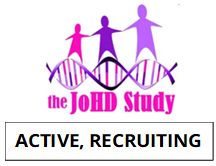JoHD
 Longitudinal Assessment of Brain Structure and Function in Juvenile-onset Huntington’s Disease
Longitudinal Assessment of Brain Structure and Function in Juvenile-onset Huntington’s Disease
Find this study on clinicaltrials.gov and the University of Iowa website.
| Sponsor | The University of Iowa / National Institutes of Health (NIH) |
| The Study | To better understand how HD affects people ages 6 - 30 by evaluating the brain structure and function of those diagnosed with Juvenile-onset HD (JoHD). The study uses advanced brain scans to track changes in brain structure and function over time to see how the disease progresses in young people. |
| Main Goals | • Learn about brain development in Juvenile-onset Huntington's Disease (JoHD) • Identify better ways to diagnose JoHD earlier • Ultimately, use what is learned to develop treatment to slow or stop JoHD |
| Who can participate? | • Ages 6 - 30 • Clinical diagnosis of JoHD • No metal in body • No history of major surgery, head trauma, brain tumor, serious chronic medical conditions other than JoHD seizures or epilepsy unrelated to JoHD |
| What is required of participants? | • For those age <18, participation by a parent or guardian • Screening process to ensure eligibility • Neurological exam • Surveys and questionnaires • Blood sample • MRI scan |
| Frequency of Participation | Two in-person visits, annually |
| Contact | Brittany Duncan at [email protected] or (713) 486-3134 |